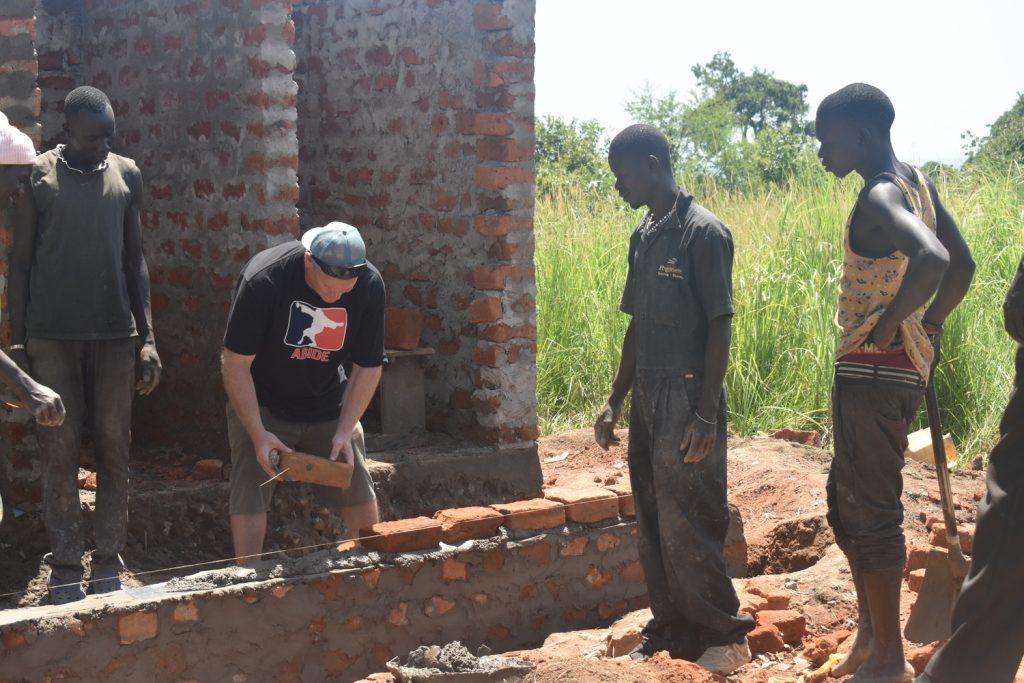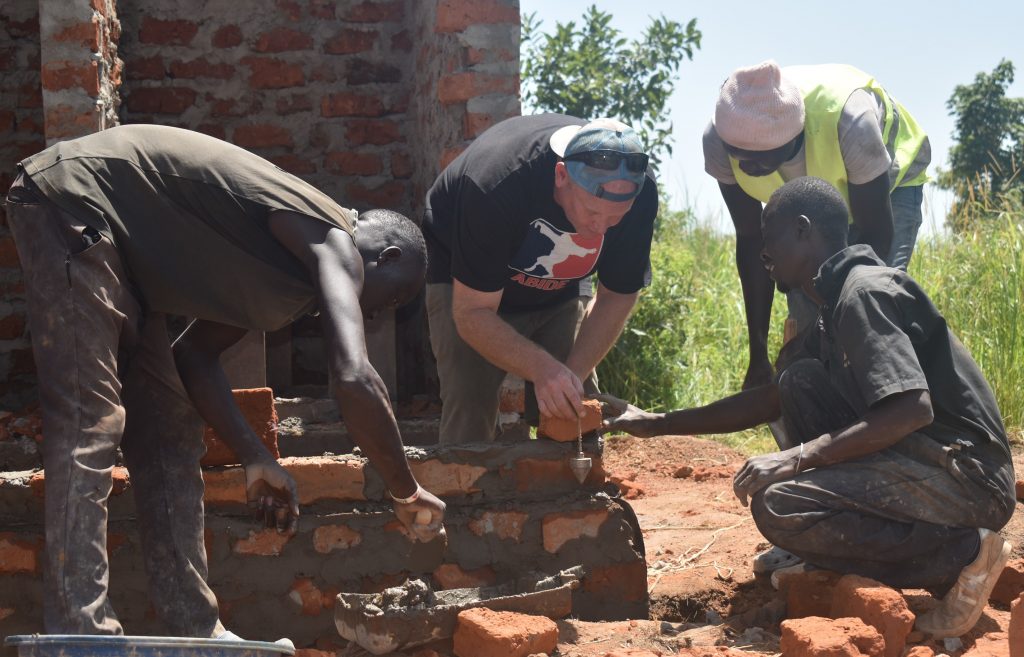Above ground work is underway, with brick and mortar walls the next in line for completion. As of the last blog, the substructure was completed and the necessary slab over the latrine pit was scheduled for Saturday’s work. Come Monday, the 15th of July, the crew commenced brick and mortar construction of the walls forming the stances, latrine enclosure, and ramps that will contour the latrine superstructure.
The sub pump served its purpose in removing the water from the pit to a desired level. A meter of water is to remain in the pit to promote proper mixing of the dung and urine to promote dilution and some mitigation of odor. The latrine pit without a base level of water is deemed inoperable, as it would be difficult to drain the pit via a ducting system or sub pump if it was allowed to remain a solid, unmixed mass of waste.
Brick and mortar work may look simplistic, like stacking children’s building blocks, but there is a science and artistry to building a sustainable wall. The mortar must harden between symmetrical spaced bricks to create an edifice that will endure rain, winds, and the test of time. Exact lining, spacing, and placement of bricks must be meticulously repeated and checked by every crew member. Teamwork, attention to detail, and collective monitoring will guarantee accurate construction and adherence to David’s engineering plans.

Plastic sheeting is laid over the base, with ample mortar spread to ensure proper adhesion in the placement of the bricks. Five centimeters of spacing allows for mortar placement between two adjoining bricks and bonds the bricks, creating a water tight seal. This provides an additional strengthening force to the weight of the bricks themselves, as the mortar dries, hardens, and stabilizes.
The plum bob has been around since ancient Egyptian times of pyramid building and is used to ensure verticality between subsequent brick layers and the alignment of the entire structure with ground level. The latrine walls must be perfectly aligned with ground level in the vertical from base to roof. This ensures even weight distribution, as the weight of one brick layer falls evenly with gravity to the layer below. Any deviation, to the slightest degree, will promote an uneven weight transfer, leaning, and lead to wall weakening, mortar disintegration, and eventual collapse.
Much care is taken to make sure every brick is lined correctly by the use of a marker string made stationary by the weight of the plum bob over the last brick. The cornerstone is set in place using plum bob alignment, as each layer extending from the cornerstone is vertically aligned with ground level. This precision is checked and rechecked with each brick layer, as alignment mistakes are negated to ensure the construction of a wall even with ground level, standing strong against the elements.

The construction plan calls for five enclosures – four for latrine stances, and a separate changing room for girls in the fifth. A command decision will have to be made by the school leaders and community on the dedicated use of the latrine stances. It is common to not have boys and girls use the same stances in such proximity for safety, privacy, and decency concerns. These are young children, not at a maturity level for communal bathrooms, even if partitioned by walls and locking doors.
In conversing with Martin, one of the school teachers, he proposed the use of this latrine as girls only, until a boy’s latrine can be constructed. The reasoning was validated by Paul, the GDPU sports director, and David the construction engineer. They both noticed about 10 girls present in the teen to preteen age range. This is good for the school and the community, and equates to them not being married off as child brides, which is common in Africa, the Middle East, Latin America, and Europe. Their attendance coincides with the work being conducted by my colleague, McLane Harrington, in Zimbabwe, and the Women Advocacy Project (WAP). They seek to promote and protect the rights of vulnerable and marginalized women and girls in Zimbabwean communities and to prevent the practice of child marriage.
The designation of this latrine for girls only may be the wisest decision the school and community makes. It will promote increased attendance by girls and help to contradict the child marriage traditions of the community and disavow the gender inequality beliefs. Women can be considered a ‘burden’ on their family and valued less than boys, and this belief must be eradicated. The tradition of marrying a girl off once she menstruates and reaches ‘womanhood’, in the eyes of the community, must be abandoned. Community systems that cling to the tradition of child marriage and undervalue the contribution and participation of girls and women limit their own possibilities for growth, stability, and transformation.
“Traditions are made by people, and can be unmade by them”, as was spoken by Graca Machel, the widow of Nelson Mandela.
Posted By Spencer Caldwell (Uganda)
Posted Jul 23rd, 2019


4 Comments
rachel wright
July 23, 2019
I love hearing about how exactly GDPU is working to construct a latrine that will last the school for years to come as well as how the latrine will impact girls specifically.
Abby Lahvis
July 23, 2019
I am so excited to see what the latrine will look like when it is done. I think it is a great accomplishment to be ahead of schedule working on such a daunting task!
Sam Nass
July 23, 2019
Again, so informative. I love hearing about the decision-making processes that you engage in with your GDPU hosts.
Emily
July 29, 2019
It’s so interesting to see how something as simple as a toilet can help prevent child marriage and other social phenomena. This is amazing!